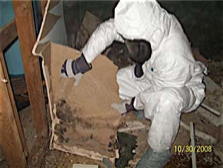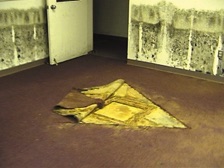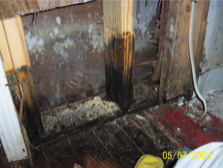Remtech specializes in turnkey mold due diligence assessments, mold sampling, abatement, cleanups, and mold remediation.
✓ Mold Assessments & Sampling (air, bulk, and performance)
✓ Mold Abatement & Remediation
✓ Mold Damage Restoration
MOLD DUE DILIGENCE
INTRODUCTION
Mold remediation claims (currently estimated at $12 billion/year) are projected to eclipse asbestos and Superfund claims combined. Recent scientific evidence linking mold to a myriad of health problems has increased public awareness. Insurance companies and financial institutions are scrambling to limit financial exposures by canceling or buying back insurance policies, defining mold exclusion clauses, and identifying mold problems prior to property transfers.
Commercial property and home owners are encountering remediation costs well above insurance coverage limits. This article presents an introduction to due diligence inquiries to assist with evaluating and limiting potential mold exposure to individuals and institutions.
MOLD HEALTH HAZARDS
Poorly constructed and tighter buildings (for energy conservation) trap moisture and increase mold growth. Molds are part of the fungus family and reproduce by spores which are the root cause of diseases. Mold spores are small (diameters ranging from 0.5 to 100 microns) and are resistant to elevated temperatures and adverse environmental conditions. Spores can be air, water, or insect-borne. Mold spores can stay dormant for years until activated by moisture, nutrients, or a host organism.
Common indoor molds include: Cladosporium, Penicillium, Alternaria, Aspergillus, and Mucor. The Center for Disease Control has documented that nine (9) percent of hospital-acquired infections are caused by fungi and mold.
The most common health effects of mold exposure include nasal stuffiness, eye and skin irritation, or wheezing. People who are allergic to molds may have more serious reactions including fever and shortness of breath or acute allergic reactions. Individuals with lung diseases may contract mold infections. People with suppressed immune systems (HIV or chemotherapy patients) are more susceptible to mold related diseases.
Molds can also produce toxic substances known as mycotoxins. Over 200 mycotoxins have been identified from common molds. Symptoms of mycotoxins exposure in the work place are: mucous membrane irritation, skin rash, nausea, immune system suppression, acute or chronic liver damage, central nervous system damage, and cancer. Additional research needs to be performed to determine the health risk of mycotoxins in indoor environments.
MOLD ENVIRONMENTAL OCCURRENCE
Molds are ubiquitous in the environment and are present indoors and outdoors year round and live in soil, plants, and on dead or decaying matter. Elevated levels of mold are found in damp and nutrient rich environments. For example, molds are found indoors in high humidity areas such as showers, damp basements, air conditioning systems, and crawl spaces. Mold growths are common after sewer backups, localized flooding, water line brakes, roof leaks, and in abandoned buildings, if water and contamination are not controlled or remediated within a 24 to 48 hour period.
MOLD IDENTIFICATION & HEALTH STANDARDS
There are currently no health standards for mold exposures. The Toxic Mold Safety and Protection Act charges regulatory agencies with the establishment of mold health standards. The Center for Disease Control recommends that musty odors, the visual presence of mold, or adverse reactions of a mold sensitive individual are triggers for mold removal and control of moisture and indoor humidity levels. Environmental sampling for mold is generally not recommended due to the lack of mold standards and the wide variation of individual mold sensitivities.
MOLD REMEDIATION CONTRACTOR QUALIFICATIONS
There is currently no approved licensing program for mold assessors or abatement contractors. Mold assessments and remediations should be conducted by experienced environmental health engineers or scientists with specific mold experience. Related existing speciality certifications include; Hazardous Waste Management engineers (The American Academy of Environmental Engineers), Certified Hazardous Materials Managers (Institute of Hazardous Materials Management), and Certified Industrial Hygienists.
MOLD ASSESSMENT GUIDELINES
Mold can occur in variety of indoor locations. Knowing where to look and how to trace moisture and water sources in a building are essential. Places where moisture can accumulate in buildings include: bathrooms, under tile, in wall cavities, insulation, drywall, wood studwork, basement floors or walls below grade, crawl spaces, under stucco facades, under coated wall paper, and in HVAC systems and ductwork. Identification of clean (drinking water or steam) or dirty water (rain, stormwater, sewage) and porosity of contacted surfaces dictates the appropriate remedial action.
MOLD REMEDIATION GUIDELINES
OSHA recently issued (October, 2003) a Safety and Health Bulletin with Guidelines for Mold Remediation. Although not mandatory, employers can be cited for violating the General Duty Clause of the Occupational Safety and Health Act which dictates that the workplace be kept free from recognized hazards.
Remediation options include cleaning of impermeable construction materials and removal and replacement of porous materials. Generally, non-toxic surfactants are recommended for cleaning. Where bleach is used, care should be exercised to remove residual chlorine. A chlorine dioxide solution or gas fumigation may be used in select applications.
Dead mold frequently leaves a toxic residue that should be removed by wet cleaning or HEPA vacuuming. Work zones that should be setup include: a contaminated zone, contamination reduction zone, and clean room. Work areas should be enclosed in plastic airlocks under negative pressure with HEPA air filtration. Personal protective gear should include full face respirators with radionuclide particulate cartridges, tyvek, nitrile gloves, and poly shoe coverings.
MOLD REMEDIATION COSTS & REIMBURSEMENT
Mold assessment and abatement costs can be substantial. Typical claims range from $10,000 to $100,000 not including personal injury claims. Mold claims may be covered by the following insurance policies: Builders Risk and Property, General and Umbrella Liability, Homeowners, Contractors Pollution Liability, and Professional Liability. Interpretation of mold exclusion clauses determines coverage.
Other sources of reimbursement have been through liability claims against insurance companies, contractors, owners of buildings, or errors and omissions of building designers or professionals who fail to exercise best management practices over site and structural water infiltration sources. The Toxic Mold Safety and Protection Act proposes tax credits and a national toxic mold hazard insurance program to assist with defraying assessment and abatement costs.
CONCLUSION
Due diligence should be exercised to avoid mold related health and financial risks to banks, insurance companies, developers, design engineers and architects, realtors, property owners, and contractors. The best protection is to ensure that your building is sited in a well drained environment and constructed of materials that limit water infiltration, leaks, or retention. Early detection and correction of building water leaks can dramatically reduce mold damage. Mold assessments conducted by competent professionals prior to property transactions and on a periodic basis can limit liabilities to homeowners and lending institutions.
Other mold risk control tips for existing buildings include: frequent inspections and preventative maintenance of roofs, foundations, water and sewage utilities; maintaining relative humidities below 50% with good ventilation and humidity controls; keeping gutters and downspouts open and ensuring that they drain away from structures; using HEPA air filters and changing on a regular bases; minimizing dust accumulation by frequent cleaning with HEPA vacuums and wet cleaning techniques; cleaning HVAC ducts on a regular basis; inspecting air conditioning condensate pumps for leaks; providing freeze protection on water lines penetrating exterior walls; cleaning sewers and traps on a regular basis; keeping large root bearing plants away from foundations; ensuring that landscapes drain away from structures; and checking basements and crawl spaces on a regular basis for settling, cracks, and/or moisture buildup.



